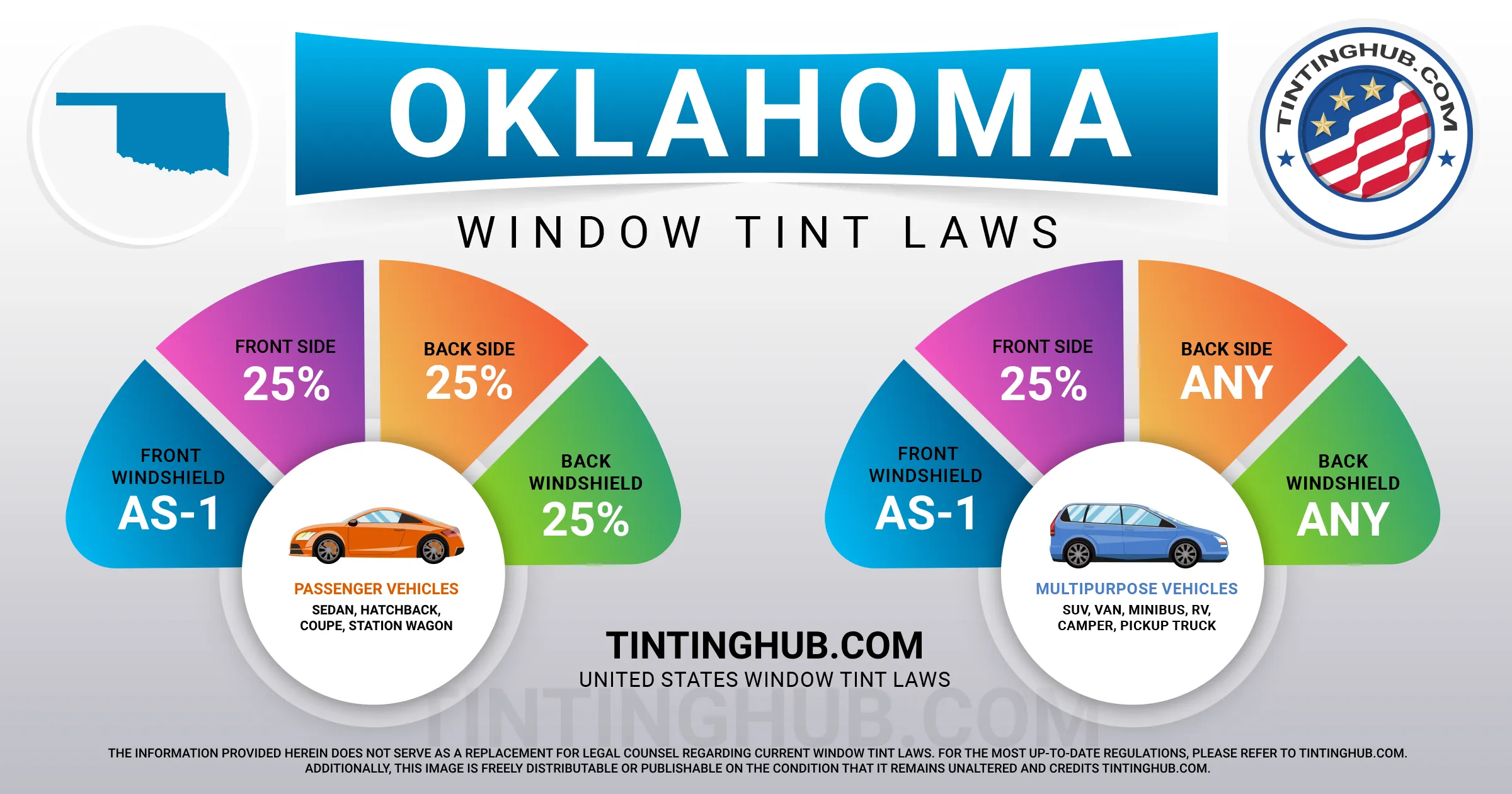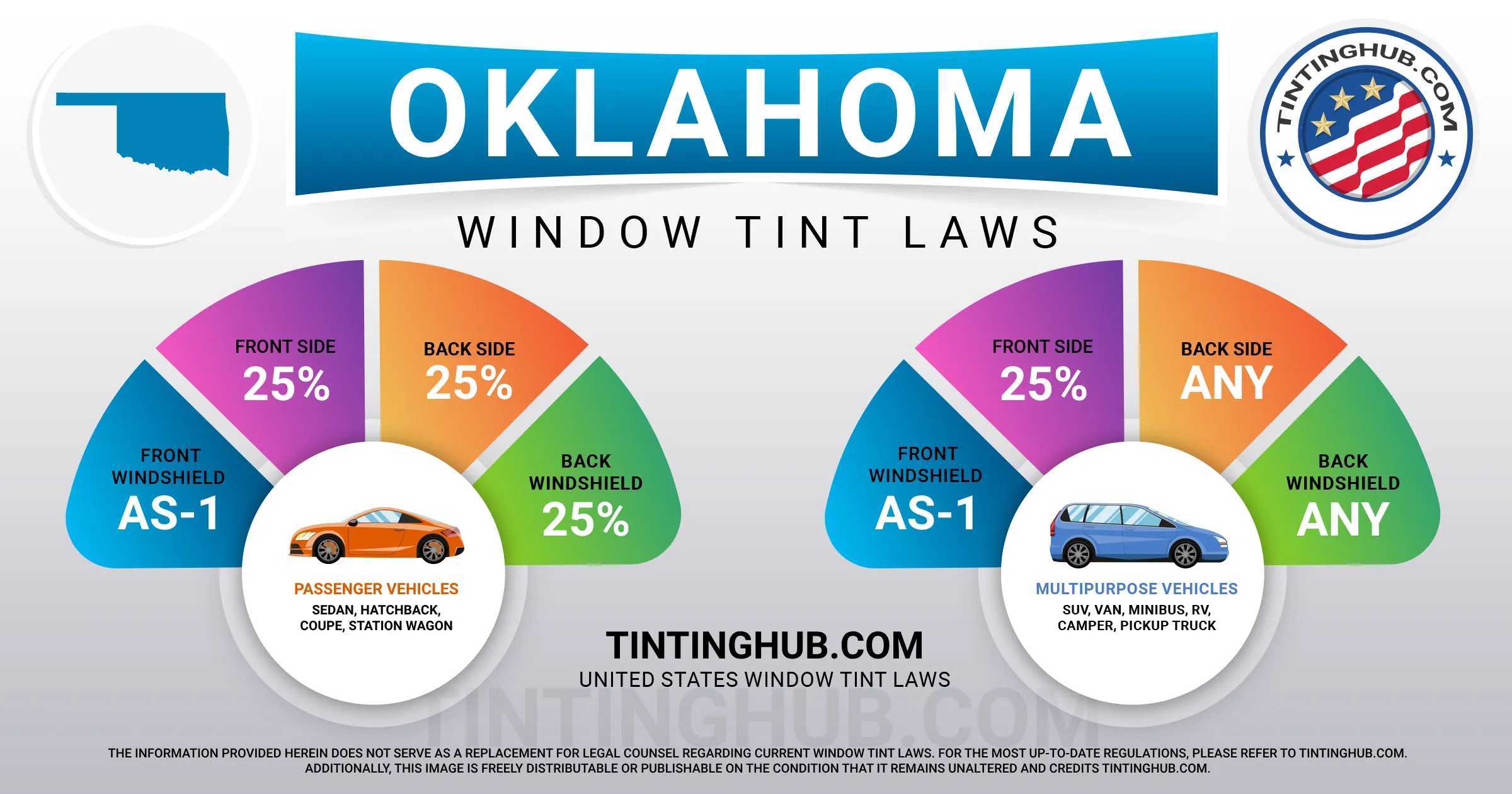Oklahoma Window Tint Laws (Last Update 2024)

Unlocking the Secrets of Oklahoma’s Window Tint Laws
When it comes to maintaining the sleek and stylish appearance of your vehicle while staying compliant with the law, understanding Oklahoma’s window tint regulations is imperative. To help you navigate the labyrinth of tinting rules, we’ve compiled this comprehensive guide to keep you on the right side of the law.

Unveiling Oklahoma’s Window Tinting Laws
Oklahoma Window Tint Law:
Sedan | MPV
- Windshield: AS-1 | AS-1
- Front Side: 25% | 25%
- Back Side: 25% | Any
- Rear Window: 25% | Any
One of the critical takeaways is that Oklahoma’s window tint laws prohibit any tinting above the AS-1 line on the windshield.
Unlocking the Tinting Year: 2005
Car window tinting laws in Oklahoma were established in 2005, setting clear guidelines on the limits and specifications for window tinting on vehicles. So, let’s delve deeper into the specifics.
Understanding Window Tint Darkness
In the world of window tinting, the term VLT (Visible Light Transmission) is pivotal. It refers to the percentage of visible light that’s allowed to pass through your vehicle’s windows.
For Sedans:
- Windshield: Non-reflective tint is allowed above the manufacturer’s AS-1 line or within the top 5 inches.
- Front Side Windows: Must permit more than 25% of light.
- Back Side Windows: Must allow more than 25% of light.
- Rear Window: Must let in more than 25% of light.
For SUVs and Vans:
- Windshield: Non-reflective tint is permitted above the manufacturer’s AS-1 line or top 5 inches.
- Front Side Windows: Must allow more than 25% of light.
- Back Side Windows: Any level of darkness can be used.
- Rear Window: Any level of darkness can be used.
Cracking the Window Tint Reflection Code
Window tinting isn’t just about darkening your windows; it can also reflect incoming light, reducing glare and heat. Oklahoma’s laws also outline the acceptable levels of window reflection.
For Sedans and SUVs:
- Front Side Windows: Must not exceed 25% reflectivity.
- Back Side Windows: Must not exceed 25% reflectivity.
Digging Deeper into Oklahoma’s Tinting Laws
Oklahoma’s tinting regulations go beyond VLT and reflection levels. Here are some other crucial rules and regulations you need to be aware of:
1. Side Mirrors: If your back window is tinted, dual side mirrors are mandatory to ensure safe visibility.
2. Restricted Colors: Oklahoma law doesn’t permit any color-altering materials on your vehicle’s windows.
3. Certificates: Film manufacturers must certify the tint they sell within the state. Always check with your dealer to ensure they’re using certified film.
4. Stickers: Unlike some states, Oklahoma doesn’t require a sticker to identify legal tinting.
5. Medical Exceptions: Oklahoma does allow medical exemptions for special tint, provided you meet the necessary criteria.
6. Penalties: Non-compliance with these regulations can result in misdemeanor charges, with penalties outlined in Section 17-101 of Oklahoma statutes.
It’s important to note that interpretations of Oklahoma’s tinting laws can vary between counties and municipalities. Therefore, we strongly recommend cross-referencing our information with your local DMV or law enforcement authorities to ensure full compliance.
Our commitment to accuracy: Our information about window tint laws in Oklahoma was last updated in 2023. If you come across any outdated or incorrect information, please don’t hesitate to reach out, and we’ll make the necessary updates.
Your Trusted Source for Window Tint Law Clarity
When it comes to deciphering the complex web of window tinting regulations, trust us to provide you with accurate, up-to-date information. As the industry leaders in delivering precise window tint law insights, we’re here to keep you informed and in compliance.